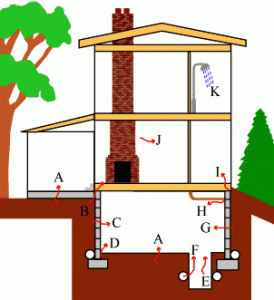“How does radon enter homes?” is one of the most common radon questions we hear. Radon is a naturally occurring radioactive gas. It is produced by the breakdown of uranium within rock, soil & water. Since it is naturally occurring, it is only natural that radon enters homes. It is odorless, tasteless, & colorless. The only way to know if radon has entered your home is to test it. Once you have tested to confirm the presence of radon in your home, our job is to take a look at how the radon entered your home.
Major Radon Entry Routes
The air pressure inside of your home is typically lower than the pressure within the soil that sits around your home’s foundation. This pressure difference acts like a vacuum. This vacuum allows the radon to enter homes. It draws the radon into your home through a variety of entry points:
A. Cracks in your foundation
B. Spaces behind brick veneer walls
C. Porous concrete blocks (as well as cracks in these blocks)
D. Floor-wall joints
E. Exposed soil in a sump pump or inside of a crawl space
F. Drain tiles that drain into an open sump
G. Mortar joints
H. Ill-fitting pipe entrances
I. Open tops of block walls
J. Directly from building materials (concrete, rocks, & bricks)
K. Well water

Radon in the air & water
It is possible for radon to enter homes through water. Well water can carry the radon into your home, where it is released into the air when water is used for showering & other common household activities. However, the risk of radon entering your home through water is much lower when compared with how radon enters a home from the soil. It should also be note that building materials rarely are the source of radon problems. When thinking of how radon enters a home, it is much more likely that the source of elevated radon levels is within the soil around your home’s foundation.
Do you have a problem with radon entering your home? We can help! Give the professionals at Trinity Radon Mitigation a call today: 630-499-1492.


